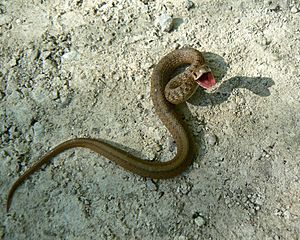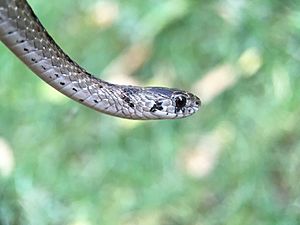DeKay's brown snake facts for kids
Quick facts for kids DeKay's brown snake |
|
|---|---|
 |
|
| Storeria dekayi | |
| Conservation status | |
| Scientific classification | |
| Genus: |
Storeria
|
| Species: |
dekayi
|
 |
|
| Synonyms | |
|
|
Storeria dekayi, commonly known as De Kay's brown snake, De Kay's snake, and simply the brown snake (along with many others), is a small non-venomous species of snake in the family Colubridae. The species is native to North America and Central America.
Geographic range
S. dekayi is native to Southern Ontario and Quebec, most of the eastern half of the United States, through Mexico, Guatemala, Honduras, and possibly El Salvador. More specifically, this common species inhabits most wetland and terrestrial habitats east of the Great Plains from sea level to 1,400 meters (4,600 feet) above sea level.
Description
Dorsally, S. dekayi is brown to gray with a lighter center stripe bordered by small black spots; ventrally, it is lighter brown or pink with small black dots at the ends of the ventral scales. Adults usually measure less than 12 inches (30 cm) in total length (including tail), but the record total length is 19+3⁄8 inches (49 cm). The dorsal scales are keeled, and it has no loreal scale. Females exceed males in snout-vent length and number of ventral scales while males exceed females in tail length, head dimensions, and number of subcaudal scales.
Habitat
S. dekayi is a lover of urban areas, and tends to frequent cities more often than the countryside. They can, of course, be found in areas such as wetlands, grasslands and forests, but they are most commonly encountered where humans are found. Moist areas are preferable habitats for them, which makes sense when you consider their favorite prey items.
Reproduction
Like other natricine snakes such as water snakes (genus Nerodia) and garter snakes (genus Thamnophis), S. dekayi is a viviparous species, giving birth to live young. Sexual maturity is reached at two to three years. Mating takes place in the spring, after snakes emerge from brumation. Between 3 and 41 young are born in late summer.
Diet
S. dekayi primarily feeds on slugs, snails, and earthworms. In the southern extent of its region the snake usually preys predominantly on earthworms, however, in the northern reaches of its range slugs are the predominant food source. It has specialized jaws that allow it to remove snails from their shells for consumption. Reports of other invertebrates (such as woodlice, mites, or millipedes) in the diet of S. dekayi are more than likely the result of accidental ingestion rather than intentional feeding, in which one of these invertebrates may have adhered to a slug or other prey item being consumed.
Ecology
S. dekayi is a prey item for larger snakes, large frogs and toads, birds, and many mammals including weasels and invasive housecats. An observed predator avoidance mechanism is coiling the anterior portion of the body and swaying it side to side as they attempt to flee. In addition to this, they release a foul musk when threatened. They are shy, secretive snakes, that are rare to find out in the open. Usually, these will be found hiding under rocks or logs for safety and comfort. They will also occasionally burrow. Their most active period is from about March 13 and October 20, but can be found year-round.
Etymology
The specific name, dekayi, is in honor of American zoologist James Ellsworth De Kay (1792–1851), who collected the first specimen on Long Island, New York, while the generic name, Storeria, honors zoologist David Humphreys Storer. However, originally, it was named Coluber dekayi.
This is the only North American snake whose binomial is a double honorific – that is, both the generic name and the specific name honor people.
See also
 In Spanish: Culebra parda de Kay para niños
In Spanish: Culebra parda de Kay para niños



